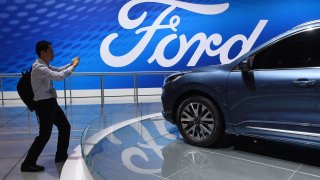
- Ford nearly doubled Wall Street's earnings expectations and slightly beat revenue projections for the third quarter.
- The results led the automaker to increase its annual guidance for the second time this year.
- Ford said increased availability of semiconductor chips and higher vehicle shipments in the third quarter enabled it to post higher-than-expected results.
DETROIT — Ford Motor nearly doubled Wall Street's earnings expectations and slightly beat revenue projections for the third quarter, leading the automaker to increase its annual guidance for the second time this year.
Here's how Ford performed versus what Wall Street expected based on average analyst estimates compiled by Refinitiv.
Get top local stories in Philly delivered to you every morning. Sign up for NBC Philadelphia's News Headlines newsletter.
- Adjusted EPS: 51 cents per share adjusted vs. 27 cents per share expected
- Automotive revenue: $33.21 billion vs. $32.54 billion expected
Ford's shares jumped by more than 9% during after-hours trading. The stock closed Wednesday down by 2.7% to $15.51 a share.
Ford on Wednesday also said it would reinstate its regular dividend starting in the fourth quarter, more than a year and a half after suspending the payments during the early days of the coronavirus pandemic.
Money Report
New guidance
The automaker's new full-year adjusted earnings guidance is between $10.5 billion and $11.5 billion, up from between $9 billion and $10 billion. Ford maintained its expectations for adjusted free cash flow of between $4 billion and $5 billion.
Baked into the new guidance are expectations for the fourth quarter that include an increase in wholesale shipments from the third quarter, combined with a continued healthy mix of vehicles sold and net pricing. Those gains are expected to be against sequentially lower results from its finance arm, Ford said.
"The results are showing, really, the underlying strength of our business," Ford CFO John Lawler told reporters Wednesday during a call.
The company increased annual guidance despite Lawler previously saying the second half of the year would be weaker than the first six months. He had cited $3 billion to $4 billion in favorable higher sales volumes, but said commodity costs, lower earnings from Ford Credit and other factors such as $500 million in higher warranty costs dragged down its results during the back end of the year.
'More to come'
Ford cited strong demand for newer products such as the Bronco SUV and Mustang Mach-E, which the company said could reach 200,000 units in sales globally a year.
"I believe we have the right plan to drive growth and unlock unprecedented value," Ford CEO Jim Farley told investors Wednesday during a call. "You're already seeing favorable change in the slope of our earnings and cash flow. There's more to come."
On an unadjusted basis, Ford's net income was $1.8 billion compared with $2.4 billion a year earlier, when dealerships and plants largely reopened after being shuttered during some of the second quarter due to the coronavirus pandemic. The automaker reported pretax adjusted earnings of $3 billion for the third quarter, down from $3.6 billion a year earlier.
Its automotive revenue was down 5% during the quarter compared with $34.7 billion in the third quarter of 2020.
2022
Ford declined to give financial guidance for 2022, but Lawler said the company expects the chip shortage to continue into next year and potentially, to a far lesser extent, into 2023. He said Ford expects a 10% increase in wholesale vehicle volumes in 2022 compared with this year, as the semiconductor shortage continues to impact the business.
Lawler also said the automaker expects commodity costs to be up $3 billion to $3.5 billion for 2021 and that they could increase another $1.5 billion in 2022.
Ford received a couple of bullish calls from Wall Street analysts heading into earnings, including an upgrade by Credit Suisse to outperform from neutral.
Ford's largest American rival, General Motors, reported third-quarter earnings Wednesday morning that beat Wall Street's estimates. Despite the beats, GM's stock declined by more than 5% during intraday trading due to the automaker lowering free cash flow guidance for the year and not meeting some investor expectations for the remainder of the year.
Separately, Farley on Wednesday said Ford would delay an over-the-air rollout of its BlueCruise hands-free highway driving system from this year until the first quarter of next year. He said the delay is to simplify the technology, which is viewed as a new recurring revenue opportunity and a way for Ford to catch up with other systems from competitors such as GM and Tesla.






